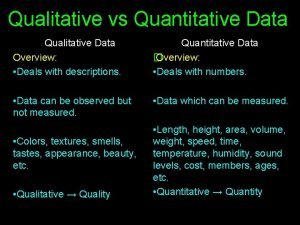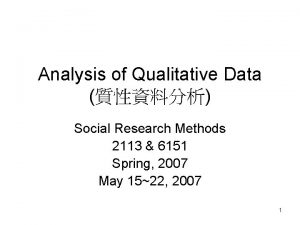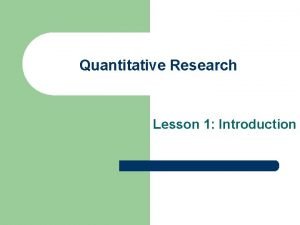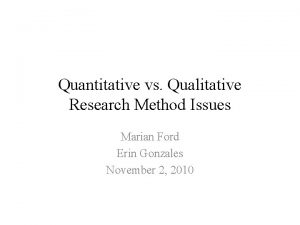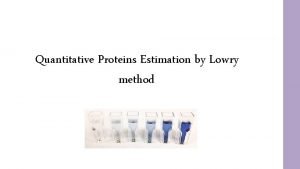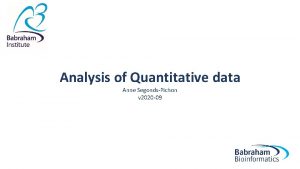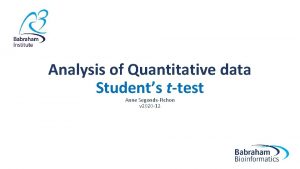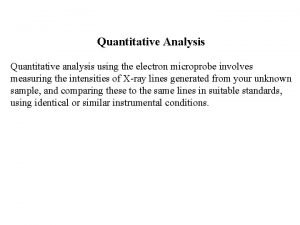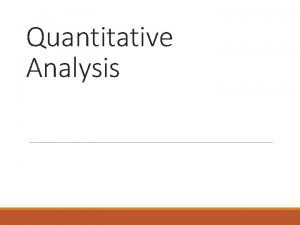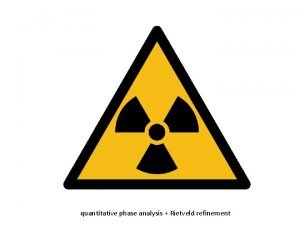Analysis of Quantitative data Introduction Anne SegondsPichon v












- Slides: 12

Analysis of Quantitative data Introduction Anne Segonds-Pichon v 2020 -12

Outline of this section • Assumptions for parametric data • Comparing two means: Student’s t-test • Comparing more than 2 means • One factor: One-way ANOVA • Two factors: Two-way ANOVA • Relationship between 2 continuous variables: Correlation

Introduction • Key concepts to always keep in mind – Null hypothesis and error types – Statistics inference – Signal-to-noise ratio

The null hypothesis and the error types • The null hypothesis (H 0): H 0 = no effect – e. g. no difference between 2 genotypes • The aim of a statistical test is to reject or not H 0. Statistical decision True state of H 0 True (no effect) H 0 False (effect) Reject H 0 Type I error α False Positive Correct True Positive Do not reject H 0 Correct True Negative Type II error β False Negative • Traditionally, a test or a difference is said to be “significant” if the probability of type I error is: α =< 0. 05 • High specificity = low False Positives = low Type I error • High sensitivity = low False Negatives = low Type II error

Sample Difference Statistical inference Meaningful? Yes Population Real? Statistical test Statistic Big enough? e. g. t, F … = Difference + Noise + Sample

Signal-to-noise ratio • Stats are all about understanding and controlling variation. Difference + Noise signal noise If the noise is low then the signal is detectable … = statistical significance signal … but if the noise (i. e. interindividual variation) is large noise then the same signal will not be detected = no statistical significance • In a statistical test, the ratio of signal to noise determines the significance.

Analysis of Quantitative Data • Choose the correct statistical test to answer your question: – They are 2 types of statistical tests: • Parametric tests with 4 assumptions to be met by the data, • Non-parametric tests with no or few assumptions (e. g. Mann-Whitney test) and/or for qualitative data (e. g. Fisher’s exact and χ2 tests).

Assumptions of Parametric Data • All parametric tests have 4 basic assumptions that must be met for the test to be accurate. First assumption: Normally distributed data – Normal shape, bell shape, Gaussian shape • Transformations can be made to make data suitable for parametric analysis.

Assumptions of Parametric Data • Frequent departures from normality: – Skewness: lack of symmetry of a distribution Skewness < 0 Skewness = 0 Skewness > 0 – Kurtosis: measure of the degree of ‘peakedness’ in the distribution • The two distributions below have the same variance approximately the same skew, but differ markedly in kurtosis. More peaked distribution: kurtosis > 0 Flatter distribution: kurtosis < 0

Assumptions of Parametric Data Second assumption: Homoscedasticity (Homogeneity in variance) • The variance should not change systematically throughout the data Third assumption: Interval data (linearity) • The distance between points of the scale should be equal at all parts along the scale. Fourth assumption: Independence • Data from different subjects are independent – Values corresponding to one subject do not influence the values corresponding to another subject. – Important in repeated measures experiments

Analysis of Quantitative Data • Is there a difference between my groups regarding the variable I am measuring? – e. g. are the mice in the group A heavier than those in group B? • Tests with 2 groups: – Parametric: Student’s t-test – Non parametric: Mann-Whitney/Wilcoxon rank sum test • Tests with more than 2 groups: – Parametric: Analysis of variance (one-way and two-way ANOVA) – Non parametric: Kruskal Wallis (one-way ANOVA equivalent) • Is there a relationship between my 2 (continuous) variables? – e. g. is there a relationship between the daily intake in calories and an increase in body weight? • Test: Correlation (parametric or non-parametric)

 Data gathering for quantitative research
Data gathering for quantitative research Qualitative vs quantitative data analysis
Qualitative vs quantitative data analysis Qualitative and quantitative data analysis
Qualitative and quantitative data analysis Basic concept of quantitative data analysis
Basic concept of quantitative data analysis Hypothesis template
Hypothesis template Qualitative data analysis coding
Qualitative data analysis coding Lesson 1 quantitative research design
Lesson 1 quantitative research design Quantitative observation
Quantitative observation Define quantitative analysis
Define quantitative analysis Lowry method of protein estimation
Lowry method of protein estimation Quantitative immunohistochemistry image analysis
Quantitative immunohistochemistry image analysis 02022009
02022009 Quantitative analysis frq ap gov
Quantitative analysis frq ap gov

